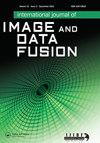Improved krill group-based region growing algorithm for image segmentation
IF 1.8
Q3 REMOTE SENSING
International Journal of Image and Data Fusion
Pub Date : 2019-04-13
DOI:10.1080/19479832.2019.1604574
引用次数: 13
Abstract
ABSTRACT Traditional image segment algorithms have some demerits: edge blur, discontinuous edge is susceptible to peripheral irrelevant information, Poor noise resistance. Therefore, we propose an improved krill group-based region growing algorithm for image segmentation in this paper. First, texture feature of the image is extracted by using Gabor filter. Then, we modify the krill group by the way that the population particle dynamics is divided into two categories: worse fitness value of particle and better fitness value of particle. The inertial weight of worse fitness value of particle is reset to zero, so as to eliminate the adverse effect of inertial weight on the current iteration of the algorithm. The inertial weight of better fitness value particle remains unchanged. The step size scaling factor in the algorithm is treated with non-linear declination to further improve the global exploring ability of the algorithm. Finally, the improved kill group optimisation is used to search for the optimal solution, and the segmentation results are finally obtained. The experimental results show that the proposed image segmentation model can not only improve the segmentation accuracy and reduce the number of iterations but also suppress the background. The contour positioning of the object area is effective.一种改进的基于磷虾群的区域生长图像分割算法
传统的图像分割算法存在边缘模糊、边缘不连续、易受外围无关信息影响、抗噪性差等缺点。因此,本文提出了一种改进的基于磷虾群的区域生长算法用于图像分割。首先,利用Gabor滤波器提取图像的纹理特征。然后,我们通过将种群粒子动力学分为两类来修改磷虾群:粒子的较差适应度值和粒子的较好适应度值。将粒子最差适应度值的惯性权重重置为零,以消除惯性权重对算法当前迭代的不利影响。较好适应度值粒子的惯性权重保持不变。对算法中的步长比例因子进行了非线性下倾处理,进一步提高了算法的全局搜索能力。最后,利用改进的kill group优化算法搜索最优解,最终得到分割结果。实验结果表明,所提出的图像分割模型不仅可以提高分割精度,减少迭代次数,而且可以抑制背景。对象区域的轮廓定位是有效的。
本文章由计算机程序翻译,如有差异,请以英文原文为准。
求助全文
约1分钟内获得全文
求助全文
来源期刊

International Journal of Image and Data Fusion
REMOTE SENSING-
CiteScore
5.00
自引率
0.00%
发文量
10
期刊介绍:
International Journal of Image and Data Fusion provides a single source of information for all aspects of image and data fusion methodologies, developments, techniques and applications. Image and data fusion techniques are important for combining the many sources of satellite, airborne and ground based imaging systems, and integrating these with other related data sets for enhanced information extraction and decision making. Image and data fusion aims at the integration of multi-sensor, multi-temporal, multi-resolution and multi-platform image data, together with geospatial data, GIS, in-situ, and other statistical data sets for improved information extraction, as well as to increase the reliability of the information. This leads to more accurate information that provides for robust operational performance, i.e. increased confidence, reduced ambiguity and improved classification enabling evidence based management. The journal welcomes original research papers, review papers, shorter letters, technical articles, book reviews and conference reports in all areas of image and data fusion including, but not limited to, the following aspects and topics: • Automatic registration/geometric aspects of fusing images with different spatial, spectral, temporal resolutions; phase information; or acquired in different modes • Pixel, feature and decision level fusion algorithms and methodologies • Data Assimilation: fusing data with models • Multi-source classification and information extraction • Integration of satellite, airborne and terrestrial sensor systems • Fusing temporal data sets for change detection studies (e.g. for Land Cover/Land Use Change studies) • Image and data mining from multi-platform, multi-source, multi-scale, multi-temporal data sets (e.g. geometric information, topological information, statistical information, etc.).
 求助内容:
求助内容: 应助结果提醒方式:
应助结果提醒方式:


